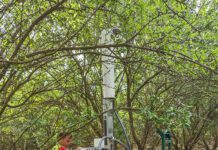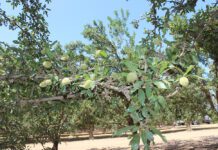With the end of a mild winter, expectations are high that insect pest pressure in tree nut orchards will grow in the coming months.
There have been reports that spider mite numbers are already high in almond orchards and early flight of navel orangeworm has occurred.
Joel Siegel, USDA research entomologist in Parlier, said that, in general, dry and warm weather favors insect pressure. Overwinter survival for pests is higher, but the dry weather has also suppressed natural fungal pathogens that can keep pests in check. Loss of green weeds earlier in the growing season will also send insect pests in to orchards, Siegel said.
Independent pest control advisor Justin Nay said navel orangeworm activity began at least two weeks earlier than normal and with that activity, comes an opportunity to produce more generations. A similar situation occurred in 2015 and hit the pistachio crop hard, he said. Almonds escaped severe damage due to the timing of the second flight and nonpareil hull split.
Tree nut pests sighted the first week of March included leaffooted bug in almonds and spider mites.
High numbers of Pacific spider mites were found during almond bloom on some ranches, Nay said. In some orchards, spider mite webbing could be seen covering the blooms. This pest has moved into orchards at both ends of the Central Valley, he said and infestations appear to be worse in orchards that had spider mite infestations last year. Beekeepers have been asked to remove bees in orchards so treatments can begin, he added.
While spider mites are proliferating, there have been few signs of predators. Nay said he has only seen one green lacewing and no predator mites in almonds.
Franz Niederholzer, UCCE orchard systems advisor in Yuba/Sutter and Colusa counties, said more insect pest pressure is expected this year due to the combination of more heat and less chill.
He is advising orchard managers to use moth/egg traps in orchards and to check them at least twice a week until biofix. Monitoring for plant bugs should also be done in March and April. If damaged nuts are found on the orchard floor, plant bugs have already been feeding for seven to 10 days. Early monitoring will be key to staying on top of pest infestations, Niederholzer said.












